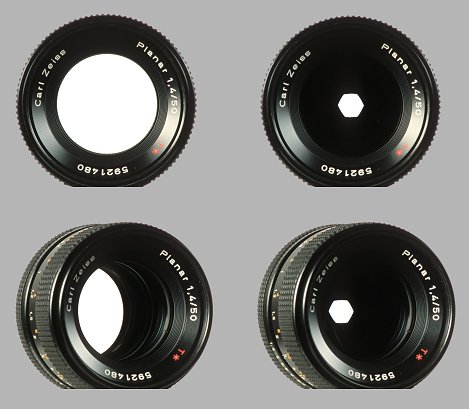For the first photo example: Longer focal length and/or wider aperture are needed. 50mm and f/2.8, especially if used on an APS-C camera, won't give that kind of bokeh that close to the focus distance. It looks to be something more like an 85mm f/1.2 on full frame with the (more or less) in focus subject at or near minimum focus distance.
Ignoring the two large round bokeh balls for a second (more on that in a bit), the lights with the largest "cats eye" shaped bokeh balls also appear to be quite a bit closer to or further from the camera that the lights with smaller bokeh that are closer to the same distance from the camera as his face.
"Cat's eye" bokeh is the result of using a very wide aperture lens where the entire entrance pupil is not visible from the angle of the widest light rays in the field of view. This results in the bokeh being vignetted into an irregular shape. The closer to the edge of the field of view the light source is, the more pronounced the distortion of the bokeh shape will be. Highlights coming from light sources near the center of the FoV will be round or nearly round because the entire entrance pupil is visible on the front of the lens from their position. Stopped down the same lens will not demonstrate the effect even for the edge rays. If a lens is designed with uncorrected field curvature, spherical aberration, or astigmatism this can make the cat's eye effect even more pronounced and/or swirly.

Based on the orientation of the direction of the "cat's eyes", which will always be tangent to the center of the lens, it appears the photo was taken with the very large bokeh ball in the exact center of the frame, then cropped to make it off center. Or it may be that the two large round bokeh balls were added in post from a different exposure. The more I look at the photo and the shape and position of the rest of the highlights bokeh, the more I am inclined to take the second view.
Then again, it might have all been done with post-processing.
In the second photo: The string of lights is much closer to the camera at the bottom of the frame than the other end of the string being held by the subject. Imagine the photographer holding the near end of the string of lights at waist level or maybe even chest level while the camera is at eye level. The top light is the out of focus and blown out moon.


